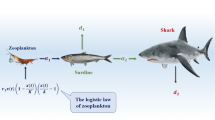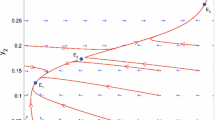Abstract
Key elements of the rapidly expanding field of ecosystem-based management include: (a) understanding connections among social and ecological systems and (b) developing analytical approaches to inform the necessary trade-offs among ecosystem services and human activities in coastal and marine areas. To address these needs, we investigate the impacts of multiple economic sectors on the marine ecosystem and dependent human community in the Gulf of California with an ecological-economic model. We focus on the spotted rose snapper (Lutjanus guttatus), an economically important species targeted concurrently by the nearshore artisanal fleet, the sportfishing fleet, and by the industrial shrimp fleet as bycatch. Economic returns to the local community are driven by the artisanal fishery catch and the number of tourists who engage in the sportsfishery, and these variables are in turn impacted by fish abundance. We find that the coexistence of the two sectors (and production of both seafood and tourism services) creates stability in key elements of the coupled systems. When the coupled systems are perturbed by changes in exploitation and climate variability, the artisanal fishery responds more rapidly and to a greater degree than the sportsfishery to shifts in the fish population. Our results suggest that vital components of coupled systems may well respond differently to climate variability or other perturbations, and that management strategies should be developed with this in mind. Models like ours can facilitate the development and testing of hypotheses about the form and strength of interactions between ecosystems, services, and the human communities that rely on them.







Similar content being viewed by others
References
Aburto-Oropeza O, Sala E, Paredes G, Mendoza A, Ballesteros E (2007) Predictability of reef fish recruitment in a highly variable nursery habitat. Ecology 88:2220–2228
Adger WN, Hughes TP, Folke C, Carpenter SR, Rockstrom J (2005) Social–ecological resilience to coastal disasters. Science 309:1036–1039
Allen GR (1985) Lutjanidae. Pargos. In: Fischer W, Krupp F, Schneider W, Sommer C, Carpenter KE, Niem V (eds) Guia FAO para Identification de Especies para lo Fines de la Pesca: Pacifico Centro-Oriental. FAO, Rome, pp 1231–1244
Allison EH, Ellis F (2001) The livelihoods approach and management of small-scale fisheries. Mar Policy 25:377–388
Amezcua F, Soto-Avila C, Green-Ruiz Y (2006) Age, growth, and mortality of the spotted rose snapper Lutjanus guttatus from the southeastern Gulf of California. Fish Res 77:293–300
Arreguin-Sanchez F, Hernndez-Herrera A, Ramirez-Rodriguez M, Prez-Espana H (2004) Optimal management scenarios for the artisanal fisheries in the ecosystem of La Paz Bay, Baja California Sur, Mexico. Ecol Model 172:373–382
Barbier EB, Koch EW, Silliman BR, Hacker SD, Wolanski E, Primavera J, Granek EF, Polasky S, Aswani S, Cramer LA, Stoms DM, Kennedy CJ, Bael D, Kappel CV, Perillo GM, Reed DJ (2008) Vegetation’s role in coastal protection. Science 320:176–177
Belgrano A, Scharler UM, Dunne J, Ulanowicz RE (eds) (2005) Aquatic food webs: an ecosystem approach. Oxford University Press, New York
Carvajal MdlÁ, Ezcurra E, Robles A (2004) The Gulf of California: natural resource concerns and the pursuit of a vision. In: Glover LK, Earle SA (eds) Defying ocean’s end. Island Press, Washington, DC, pp 105–124
Chan KMA, Shaw R, Cameron D, Underwood EC, Daily GC (2006) Conservation planning for ecosystem services. PLoS Biol 4:e379
Christensen V, Walters CJ (2004) Ecopath with Ecosim: methods, capabilities, and limitations. Ecol Model 172:109–139
Clark CW (1990) Mathematical bioeconomics: optimal management of renewable resources. Wiley, Hoboken
Clark CW (2006) The worldwide crisis in fisheries: economic models and human behavior. Cambridge University Press, New York
Cudney-Bueno R, Bourillón L, Sáenz-Arroyo A, Torre-Cosío J, Turk-Boyer P, Shaw WW (2009a) Governance and effects of marine reserves in the Gulf of California, Mexico. Ocean Coast Manag 52:207–218
Cudney-Bueno R, Lavín MF, Marinone SG, Raimondi PT, Shaw WW (2009b) Rapid effects of marine reserves via larval dispersal. PLoS ONE 4:e4140. doi:4110.1371/journal.pone.0004140
Daily GC (ed) (1997) Nature’s services: societal dependence on natural ecosystems. Island Press, Washington, DC
Fedler AJ, Ditton RB (1994) Understanding angler motivations in fisheries management. Fisheries 19:6–13
Fletcher CS, Hilbert DW (2007) Resilience in landscape exploitation systems. Ecol Model 201:440–452
Folke C, Carpenter S, Walker B, Scheffer M, Elmqvist T, Gunderson L, Holling CS (2004) Regime shifts, resilience, and biodiversity in ecosystem management. Annu Rev Ecol Syst 35:557–581
Gaylord B, Gaines S, Siegel D, Carr M (2005) Marine reserves exploit population structure and life history in potentially improving fisheries yields. Ecol Appl 15:2180–2191
Glynn PW (1988) El Niño Southern Oscillation 1982–83: nearshore population, community and ecosystem responses. Annu Rev Ecol Syst 19:309–345
Gordon HS (1954) The economic theory of a common property resource: the fishery. J Political Econ 62:124–142
Halpern BS, Walbridge S, Selkoe KA, Kappel CV, Micheli F, D’Agrosa C, Bruno JF, Casey KS, Ebert C, Fox HE, Fujita R, Heinemann D, Lenihan HS, Madin EMP, Perry MT, Selig ER, Spalding M, Steneck R, Watson R (2008) A global map of human impacts on marine ecosystems. Science 319:948–952
Hare SR, Mantua NJ (2000) Empirical evidence for North Pacific regime shifts in 1977 and 1989. Prog Oceanogr 47:103–145
Hernández A, Kempton W (2003) Changes in fisheries management in Mexico: effects of increasing scientific input and public participation. Ocean Coast Manage 46:507–526
Hilborn R, Walters CJ (1992) Quantitative fisheries stock assessment. Chapman and Hall, New York
Holling CS (1973) Resilience and stability of ecological systems. Annu Rev Ecol Syst 4:1–23
Kaplan IC, Levin PS (2009) Ecosystem-based management of what? An emerging approach for balancing conflicting objectives in marine resource management. In: Beamish R, Rothschild B (eds) The future of fisheries science in North America. Springer, Berlin Heidelberg New York
Laukkanen M (2001) A bioeconomic analysis of the Northern Baltic salmon fishery: coexistence versus exclusion of competing sequential fisheries. Environ Resour Econ 18:293–315
Leslie HM, McLeod KL (2007) Confronting the challenges of implementing marine ecosystem-based management. Frontiers Ecol Environ 5:540–548
Levin SA, Goodyear CP (1980) Analysis of an age structured fishery model. J Math Biol 9:245–274
Levin SA, Lubchenco J (2008) Resilience, robustness, and marine ecosystem-based management. BioScience 58:27–32
MA (2005) Millennium Ecosystem Assessment (MA) synthesis report. Millennium Ecosystem Assessment, Washington, DC, pp 219
McGowan JA, Cayan DR, Dorman LM (1998) Climate-ocean variability and ecosystem response in the Northeast Pacific. Science 281:210–217
McLeod KL, Leslie HM (eds) (2009) Ecosystem-based management for the oceans. Island Press, Washington, DC
Nelson DR, Adger WN, Brown K (2007) Adaptation to environmental change: contributions of a resilience framework. Annu Rev Environ Resour 32:395–419
Olaussen JO, Skonhoft A (2005) The bioeconomics of a wild Atlantic salmon (Salmo salar) recreational fishery. In: Working paper series 6105, Department of Economics, Norwegian University of Science and Technology
Parrish JD (1987) The trophic biology of snappers and groupers. In: Polovina JJ, Ralston S (eds) Tropical snappers and groupers: biology and fisheries management. Westview Press, Boulder, pp 405–464
Perez-Mellado JL, Findley LT (1985) Evaluacion de la Ictiofauna del camaron capturado en las costa de Sonora y norte de Sinaloa, Mexico. In: Yanez-Arancibia A (ed) Recursos Pesqueros Potenciales de Mexico: La pesca acompanante del caramaron. Prog. Univ. de Alimentos, Inst. Cienc. del Mar y Limnol., INP, UNAM, Mexico City, pp 201–254
Poder Ejecutivo Federal (2007) Ley General de Pesca y Acuacultura Sustentables. Diario Oficial de la Federación, 24 July 2007
Polis GA, Rose MD, Sánchez-Piñero F, Stapp PT, Anderson WB (2002) Island food webs. In: Case TJ, Cody ML, Ezcurra E (eds) A new island biogeography of the sea of Cortés. Oxford University Press, New York, pp 362–380
Polovina JJ, Ralston S (1987) Tropical snappers and groupers: biology and fisheries management. Westview Press, Boulder
Ralston S (1987) Mortality rates of snappers and groupers. In: Polovina JJ, Ralston S (eds) Tropical snappers and groupers: biology and fisheries management. Westview Press, Boulder, pp 375–404
Rosenberg AR, Sandifer P (2009) What do managers need? In: McLeod KL, Leslie HM (eds) Ecosystem-based management for the oceans. Island Press, Washington, DC, pp 13–32
SAGARPA (2001) Anuario Estadistico de Pesca. Secretaria de Agricultura, Ganaderia, Desarrollo Rural, Pesca, y Alimentacion, Mexico
Smith MD, Wilen JE (2003) Economic impacts of marine reserves: the importance of spatial behavior. J Environ Econ Manage 46:183–206
Smith ADM, Fulton EJ, Hobday AJ, Smith DC, Shoulder P (2007) Scientific tools to support the practical implementation of ecosystem-based fisheries management. ICES J Mar Sci 64:633–639
Southwick Associates, Nelson Resources Consulting, FIRMUS Consulting (2008) The economic contributions of anglers to the Los Cabos economy. The Billfish Foundation, Fort Lauderdale, p 126
Tallis H, Kareiva P, Marvier M, Chang A (2008) An ecosystem services framework to support both practical conservation and economic development. Proc Natl Acad Sci USA 105:9457–9464
Thomson DA, Findley LT, Kerstitch AN (2000) Reef fishes of the Sea of Cortez: the rocky-shore fishes of the Gulf of California. University of Texas Press, Austin
UNCED (United Nations Conference on Environment and Development) (1992) Report of the United Nations conference on environment and development. United Nations, Rio de Janeiro
UNEP (2006) Marine and coastal ecosystems and human wellbeing: a synthesis report based on the findings of the Millennium Ecosystem Assessment. UNEP, pp 76
USCOP (2004) An ocean blueprint for the 21st century: final report of the US Commission on Ocean Policy (USCOP). USCOP, Washington, DC
Velarde E, Ezcurra E, Cisneros-Mata MA, Lavin MF (2004) Seabird ecology, El Niño anomalies, and prediction of sardine fisheries in the Gulf of California. Ecol Appl 14:607–615
Young RH, Romero JM (1979) Variability in the yield and composition of bycatch recovered from Gulf of California shrimping vessels. Trop Sci 21:249–264
Acknowledgments
We thank M. Baskett, J. Dushoff, E. Ezcurra, D. Menge, A. Kinzig, J. Rich, and A. Satake for valuable discussions during the development of this work. Comments by the Editors and two anonymous reviewers significantly strengthened this manuscript. HL acknowledges the support of The David and Lucile Packard Foundation, The James S. McDonnell Foundation (through the Santa Fe Institute’s Robustness Program), the Princeton Environmental Institute, and Brown University’s Center for Environmental Studies. MS acknowledges the support of a Marie Curie International Fellowship within the 6th European Community Framework Programme and a Society in Science—Branco Weiss—Fellowship. RCB acknowledges the support of the David and Lucile Packard Foundation and the PANGAS Project.
Author information
Authors and Affiliations
Corresponding author
Additional information
H. M. Leslie and M. Schlüter contributed equally to this paper.
Electronic supplementary material
Below is the link to the electronic supplementary material.
Appendix A1: Stability analysis of the fish population sub-model (PDF 414 kb) including five figures:
Figure A1: Stable (below curve) and instable (above curve) parameter space of the fish population model. Note the log of the y-axis
Figure A2: Changes in juvenile (left) and adult (right) fish abundances with different reproductive and immigration probabilities. The darker the color the higher the abundance
Figure A3: The abundance of both juvenile and adult fish sharply changes with changes in the sportsfishing scaling parameter β and the artisanal effort threshold (R C )
Figure A4: Effort, catch, and returns to the artisanal and sportfishing sectors change considerably with changes in the sportsfishing scaling parameter (β)
Figure A5: Returns and effort in the artisanal and sportsfishing sectors change markedly with changes in the sportsfishing scaling parameter β. Scenarios A, B, and C refer to our three ‘system states’: the artisanal-dominated state, the coexistence state, and the sportsfishery-dominated state
About this article
Cite this article
Leslie, H.M., Schlüter, M., Cudney-Bueno, R. et al. Modeling responses of coupled social–ecological systems of the Gulf of California to anthropogenic and natural perturbations. Ecol Res 24, 505–519 (2009). https://doi.org/10.1007/s11284-009-0603-8
Received:
Accepted:
Published:
Issue Date:
DOI: https://doi.org/10.1007/s11284-009-0603-8




